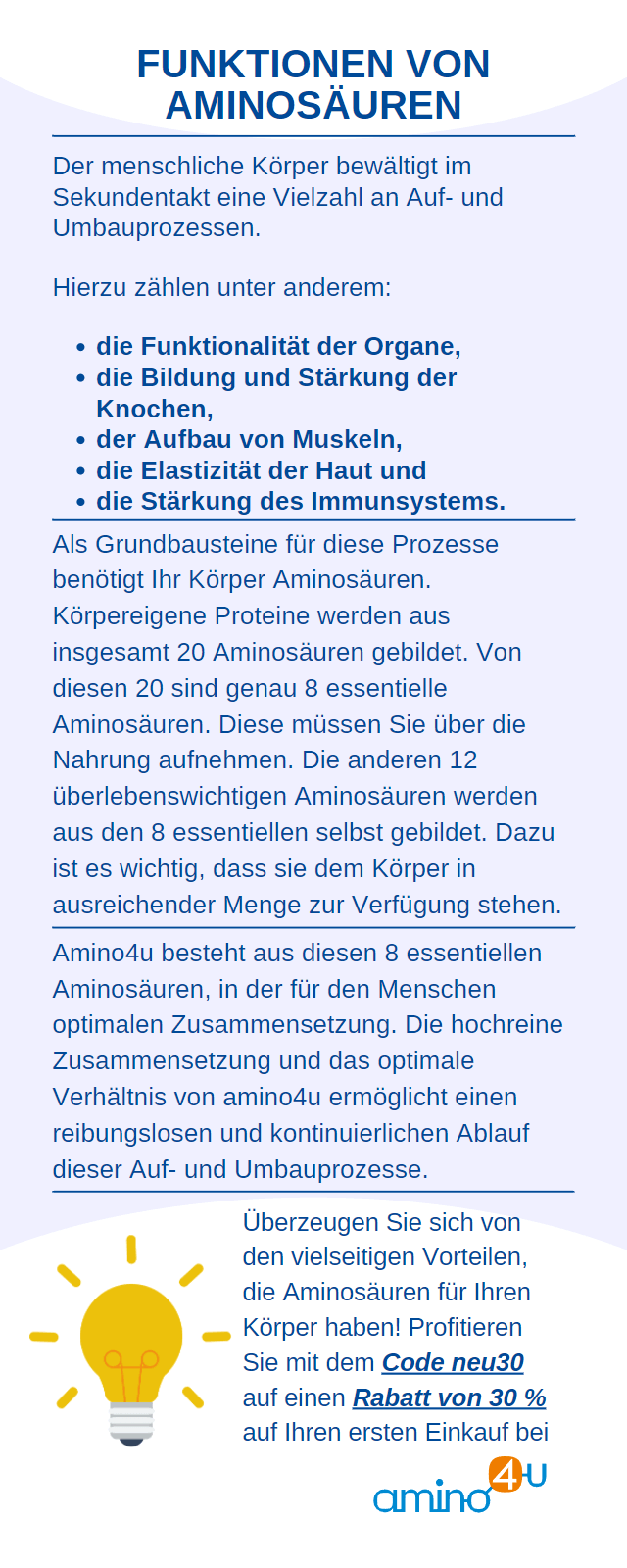What are branched chain amino acids? Valine, leucine and isoleucine are 3 protein building blocks that are particularly valued by many athletes and health-conscious people during physical exertion and when building muscle. Have you ever heard of these aminos, which are abbreviated with the letters
BCAA ? Could you perhaps benefit from consuming branched-chain protein building blocks? What do scientists and nutritional doctors say on the subject? We have put together the most important information for you here.

What are branched chain amino acids?
Many people equate the term “
amino acid ” with egg white or protein. By protein you usually mean the macronutrients that we need for our diet in addition to fats and carbohydrates. This assumption is partly correct, but simplified.
Amino acids are the building blocks of the proteins mentioned. In any case, this applies to 20 representatives of around 300 of these organic compounds that scientists call proteinogenic. They are built into the human genome so that they can form the building material for proteins. Of these
20 chemical compounds, 8 are considered essential. There are also non-essential amino acids. If a protein building block is essential, the human body cannot produce it itself, but must supply it regularly through the diet. Leucine, isoleucine and valine are also
essential amino acids and have some special features.
 A special chemical structure
A special chemical structure
Proteinogenic amino acids such as leucine, valine and isoleucine are summarized under the heading “
BCAA ” in English usage. This abbreviation stands for “
Branched-Chain Amino Acids ”. Leucine, valine and isoleucine have in common that their chemical structure has a branched structure that distinguishes them from other aminos.
How do metabolic processes in the muscles work under stress?
The
branched-chain protein building blocks are metabolized less intensively in the liver than other proteins. The body processes them mainly in other tissues such as the muscles. In order to understand the function of the branched proteins in muscle tissue under tension, let's take a closer look at the metabolism of our muscles: Two proteins are
particularly common in the skeletal muscles of the human body: glutamine and alanine. When you exercise your body intensively, large amounts of glutamine are converted into alanine. The muscle cells constantly release more alanine into the blood. Energy is stored in the liver in the form of carbohydrates (sugar). This is glycogen storage. The entire organism needs the energy from this glycogen store under heavy stress. This storage in the liver empties the more intense the stress and the longer it lasts. The amino acid alanine, which has been released into the blood, can also be converted into sugar in the liver to provide further energy. So when you exert yourself, your liver demands additional alanine. If more and more
glutamine and alanine are broken down in the muscle due to exercise, the muscle enters a degrading (“
catabolic ”) state without renewed supply of proteins.
How can you provide quick protein replenishment and maintain muscle?
Valine, leucine and isoleucine have aroused the interest of athletes, among other things, because they can be quickly converted into glutamine again through their
metabolism in the muscles during exercise. If there are not enough of them circulating freely in the bloodstream for the body to use, proteins in the muscle tissue itself break down. If you want to maintain muscle and, if necessary, build it further with exercise, it is best to ensure you have enough leucine, valine and isoleucine in the freely available form.

What are the benefits of taking it in relation to physical exertion and in general?
Scientists and sports doctors discuss an anti-catabolic effect for the three protein building blocks mentioned. They assume that
branched-chain amino acids could protect muscles from breakdown. Scientific research in this area is not yet complete. For leucine in particular, various scientific studies indicate that this building block can do even more. Regulatory effects on insulin metabolism are assumed. The protein building block could also play a role in the formation
of the human growth hormone HGH . In general, branched protein building blocks should not only protect against muscle breakdown, but also promote
muscle building processes and the healing of muscle injuries. It still remains to be seen whether leucine, valine and isoleucine can potentially slow down
aging processes in the muscles. Scientists are also researching the effect of leucine on the
stress hormone cortisol . You can find information about the
potential effects of BCAA in these scientific studies, among others:

How and when do you administer valine, leucine and isoleucine?
Good natural sources for the branched protein building blocks include peanuts, tuna, eggs and chicken breast. You can also take the proteins as
dietary supplements . Many
athletes and nutrition experts recommend taking it around 90 minutes after intensive exercise. To date, this time-based intake recommendation has not been fully scientifically substantiated. Since a general protein intake is often recommended in connection with building muscle some time after exercise, we can estimate the intake of these specific proteins to be equivalent.
Dosage as a dietary supplement
Nutritionists do not yet know exactly what amounts of branched protein building blocks our human organism needs. There seem to be very
individual differences .
The requirement for isoleucine is 42-48 mg per kilo of body weight.
Leucine intakes of up to 500 mg per kilogram of body weight are considered harmless. Athletes and trainers derive recommendations of between 10 grams and 70 grams as a supplement to the diet during periods of stress.

Medical applications of protein building blocks
In the medical field
, leucine, valine and isoleucine are used for certain liver and muscle breakdown diseases (e.g.
liver cirrhosis ). Scientific research into the potential medical effects has not yet been completed.
Other effects on the body's own substances
When absorbed into the brain, the branched protein building blocks are in direct competition with other proteins such as tryptophan. There is also a connection to insulin metabolism. The extent to which these other potential effects of leucine, valine and isoleucine affect health continues to be investigated and positive effects are suspected.
Previous findings in the summary
Many athletes, but also health-conscious people, have had good experiences with additional intake in the form of an
amino acid nutritional supplement to improve their fitness. There are different
amino acid preparations : We at amino4u have decided to produce a
product with all eight essential amino acids . There is increasing evidence that older people in particular can benefit from leucine, valine and isoleucine for their health. This is particularly about
maintaining physical performance and muscles. Older people lose muscle more quickly because muscle loss is part of the typical aging process. This is where these special proteins could come into play. Liver health could also generally benefit from the protein building blocks, although if you have liver disease you should consult your doctor before use.

 A special chemical structure
A special chemical structure


